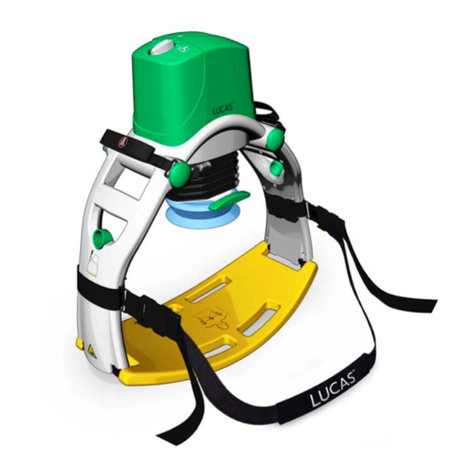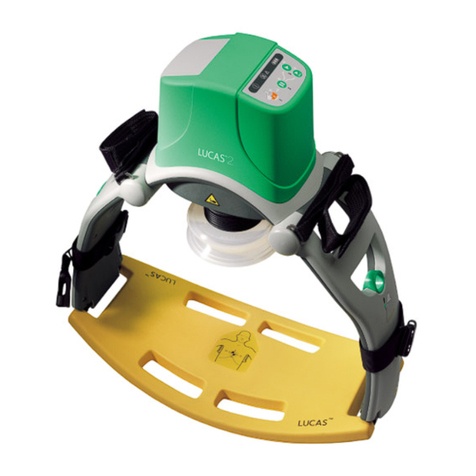LUCASTM2 Chest Compression System – Instructions for Use
100666-01 B Valid from CO J2548, © 2011 JOLIFE AB
8
2.7 User Control Panel
ON/OFF:
LUCAS will power up/power down when
you push this key for 1 second. When
LUCAS powers up, it automatically does
a self-test of the functions and the
protection/safety system. When the self-
test is complete the green LED (Light
Emitting Diode) beside the ADJUST key
illuminates. This procedure takes
approximately 3 seconds.
ADJUST:
This mode is used when you want to
adjust the position of the Suction Cup.
When you push this key, you can move
the Suction Cup up or down. To adjust
the Start Position of the Suction Cup,
push down the Suction Cup down with
two fingers onto the chest of the patient.
PAUSE:
Whenyou pushthis key,the compression
mechanism temporarily stops and is
locked in the Start Position. Use this
function when you want to stop LUCAS
temporarily but still want to keep the
Suction Cup's Start Position.
ACTIVE (continuous):
When you push this key, LUCAS
performs continuous chest
compressions. The green LED signal will
blink 8 times per minute to indicate the
time to ventilate during continuous
compressions.
ACTIVE (30:2):
When you push this key, LUCAS
performs 30 chest compressions and
then temporarily stops for 3 seconds.
Duringthestop, the operator can perform
2ventilations. Then thecyclestartsagain.
An intermittent LED, in combination with
an alarm signal will alert the operator
before each ventilation pause.
MUTE:
If you push this key when LUCAS is
operating, you mute the alarm for 60
seconds. If you push this key when
LUCAS is powered OFF, the Battery
indicator shows the charge status of
the Battery.
Battery indicator:
The three green LEDs show the Battery
charge status:
• Three green LEDs: Fully charged
• Two green LEDs: 2/3 charged
• One green LED: 1/3 charged
•OneintermittentorangeLEDandalarm
during operation: low battery, approxi-
mately 10 minutes of operating capacity
remaining.
• One intermittent red LED and an alarm
signal: the Battery is empty and must be
recharged.
• One constant red LED and an alarm
signal: the Battery is defective.
Note: When the LED to the far right is
orange and not green, the Battery has
reachedtheendofitsservicelife.JOLIFE
AB recommends that you replace this
Battery with a new one.
Alarm indicator:
A red LED and an alarm signal indicate
malfunction.
Refer to Troubleshooting 8;
8.1 for indications and alerts during normal
operation.
8.3 for malfunction alarms.






























